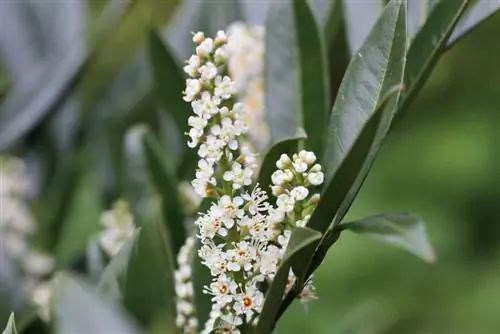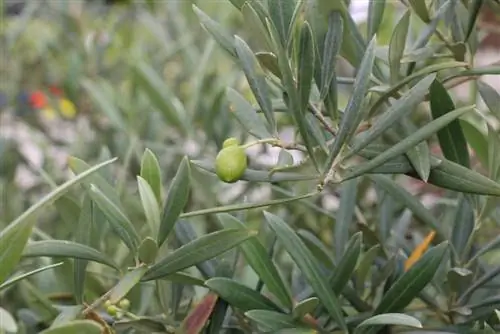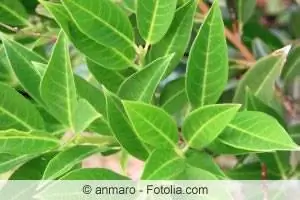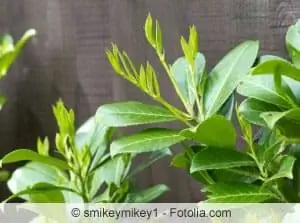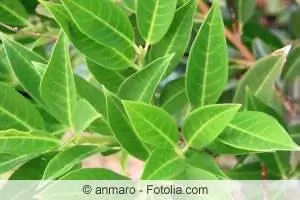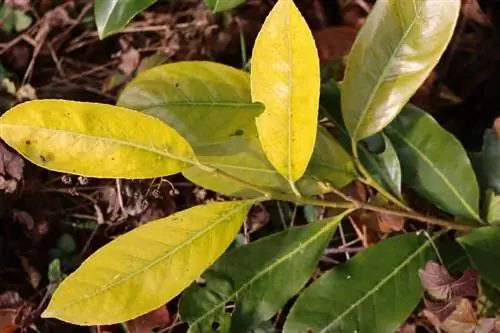- Author admin [email protected].
- Public 2023-12-17 03:39.
- Last modified 2025-01-24 12:45.
The cherry laurel is native to western Asia and southeastern Europe. While it grows there as a tree, as a shrub it can reach a height of 2-4 m. The grape-shaped flowers, which are up to 12 cm long, appear in the period from April to May. The drupes, which are similar to cherries, develop from August to September. The pleasant scent is reminiscent of bitter almond. Cherry laurel oils are also used in medicine.
Cherry laurel is an evergreen tree. It is often grown as a hedging plant. Almost all cherry laurel is poisonous but very easy to care for. Brown leaves are often due to frost damage, but with proper pruning they can provide enough space for new shoots.
Locations and care
You should preferably choose a humus-rich and nutrient-rich loamy soil for planting. Since the cherry laurel is relatively undemanding, it also thrives on dry and sandy soils. There are also no restrictions on growth with regard to the pH value. Soils that are compacted and therefore retain moisture are relatively unsuitable as a location. There are no high demands on care for this hedge. The plants should be supplied with compost and horn meal at the end of March. A stock fertilizer is also suitable for this. Frost-resistant leaves can be obtained by fertilizing with patent potash at the end of August. Enrichment with nutrients such as potassium is therefore ensured.
Ideal times for cutting
Basically, you can cut the cherry laurel almost all year round. The exceptions are the times of flowering and frost. If the plant is growing strongly, it is possible to cut it back twice a year. If you only plan to shorten the cherry laurel, i.e. only cut it once a year, June is best suited for this. If you notice frost damage, such as brown leaves, cutting should definitely be done in spring. It is necessary to cut back vigorously so that the young shoots have enough space to give the hedge a he althy appearance. This procedure is also advisable for older cherry laurel plants. The light necessary for growth reaches even the smallest shoots. For a short-trimmed hedge, the ideal time to trim is before the shoots begin. When cutting in spring, this should be done immediately after flowering. This is the only way to ensure that the resulting inflorescences remain unharmed.
The right cut
The choice of tool is crucial here. As expected, hedge trimmers are not suitable for this. It is best to use sharp secateurs. This means the leaf bases are not injured and the cut can be better coordinated. Depending on necessity or your own taste, the branches can only be shortened or a more radical form of cutting can be used, namely right down to the old wood. As a rule, the wood grows he althy and strong again. If the cherry laurel is sick, you can cut it back almost to the ground. It is ideal to use a day when it is dry but the sky is cloudy. Before cutting, allow two centimeters above the base of the leaf. In order for the hedge to look opaque and he althy, it must have the opportunity to branch. This can be achieved by shortening the new growth by half. This is particularly recommended for young hedges. This way they don't grow up too quickly.
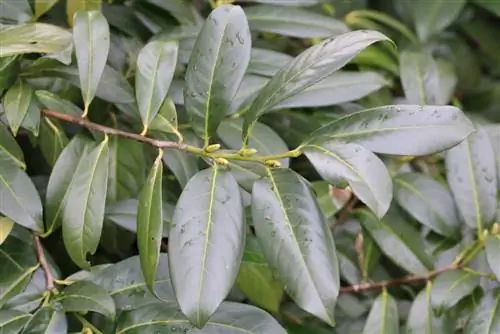
Suitable time for pruning
The best time for this is in June. Then one cut per year is enough. In principle, cutting can be done all year round as long as it is a frost-free day. Of course you don't cut it while it's blooming. If you prune late in the summer, you remove the flower heads for the coming year. That's why June is the best time:
- You wait until the breeding season for the birds is over before cutting if they have chosen the plant as a breeding place.
- Dry, windless days are favorable for pruning, when fungal spores have a hard time infecting interfaces.
How to cut cherry laurel?
For pruning you use secateurs, not hedge trimmers. You shouldn't use electric scissors or petrol engine scissors because they will shred a lot of leaves, which doesn't look nice. With secateurs and a lot of time and desire it takes longer, but not a single leaf is damaged. You choose a loose cut.
If you want to achieve a particularly bushy hedge shape, this year's new growth should be shortened by about half. This is important for young hedges, otherwise they will grow too quickly without branching out strongly in the lower area. The hedge can be trimmed a little higher every year. So it grows slower, but becomes nice and dense and stable.
Editor’s Tips
- After flowering, the dead shoots should be cut back to strong buds or young shoots.
- With old bushes, remove a few old shoots at the base so that the hedge becomes a little thinner from below.
- The cherry laurel can also tolerate a radical cut deep into the old wood. He willingly drives out again.
- Cherry laurel plants that do not bloom are best cut in spring, before budding.
Pests and diseases
Fungal diseases that show up as brown spotty leaves are to be expected, especially in quite wet years. Yellow leaves, on the other hand, indicate damage caused by drought. Regardless of what the cause is, the leaves need to be removed. The shoots that have dried out are cut back to he althy wood. Under no circumstances should it be disposed of in the compost heap. Aphids can also attack cherry laurel. If you find that these parasites do not disappear naturally, you can resort to special fungicides. However, preparations that are produced ecologically, for example based on rapeseed oil, are better. The black weevil is a widespread pest of cherry laurel. The roots are eaten by the larvae that live in the soil. Adult beetles are difficult to control. They cause clearly visible damage to the leaves. The edges are corroded like waves. At the first signs of the black weevil, ideally in the larval stage, HM nematodes have proven effective for minimization.

